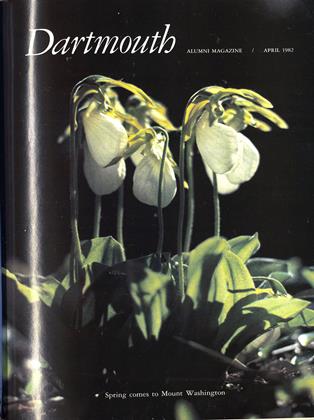Behind closed doors and blinded widows in the Lower Jewett Corridor, a floor beneath the mainstream of traffic passing the Hopkin Center snack bar, is the metalworking shop, full of formidable-looking machinery. It is one of the College's four student workshops, the other three being woodworking, ceramics, and jewelry.
In an effort to publicize metalcraft and the shop's capabilities, a series of workshop demonstrations was held in the metal working shop during winter term. Techniques were demonstrated, and students were encouraged afterward to have a go themselves under the guidance of various local artisans and Bruce Cate, instructor in metalworking. Cate and Peter Robbie, workshops director, were out to familiarize students with some of the more traditional methods of creating objects through heat. Metalworking is a little intimidating to people," explained Cate. "Everyone has seen at least hammers and nails, so it is easy to walk into the woodworking shop, but metalwork is not something familiar to most students."
At one workshop, Cate readied the forge 10 demonstrate some basic blacksmithing As he worked, he commented on the relative safety of metalwork. "Here you have a lot of control. You bring your work to the machinery or the heat source rather than the reverse, as is the case with the occasionally hazardous radial-arm saw used in woodworking." Cate repeatedly heated a rectangular rod of steel and demonstrated the use of hammer and anvil in pursuit of the pointed end. Using a wrench and vise, he showed how to create the twist often seen in wrought iron work.
At another workshop, glassblowing was demonstrated by local artisans Susan and Michael Kraatz. As Michael created a goblet, Susan explained his techniques to the gathered crowd. The opportunity to work with glass has only recently become available, made possible by Cate's construction of a glass oven.
Many of the pieces produced in the metal shop are modern in design, but they are carefully crafted with the traditional, time-consuming skills passed down from century to century. Cate explained the logic of preferring to weld two pieces of steel together painstakingly at the forge when he could much more quickly solder or gasweld them: "You do it like this because it's harder. It's the way it has always been done."
Shop instructor Bruce Cate demonstrates the ancient craft of working red-hot iron on theanvil, while Michael Kraatz
Delicately fashions a goblet.
 View Full Issue
View Full Issue
More From This Issue
-
 Feature
FeatureHotsy Totsy
April 1982 By Lomax Littlejohn -
 Feature
FeatureThe Man Behind the Green
April 1982 By Rob Eshman -
 Feature
FeatureEnd of a Golden era
April 1982 By Shelby Grantham -
 Cover Story
Cover StoryOn Mount Washington, where the Geum Peckii blooms and blows
April 1982 By Peter Heller -
 Article
ArticleCONSTITUTION OF THE COUNCIL OF THE ALUMNI OF DARTMOUTH COLLEGE
April 1982 -
 Article
ArticleSeer in the Dark
April 1982 By Mary Ross








